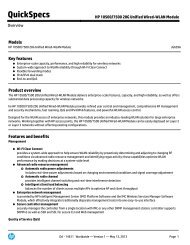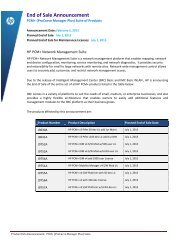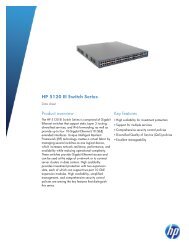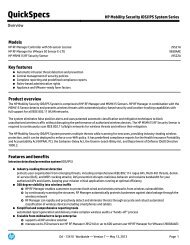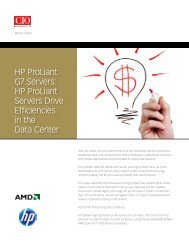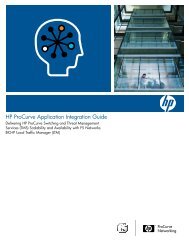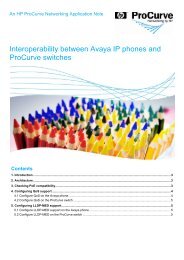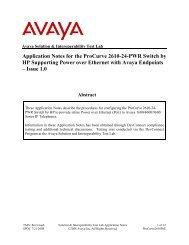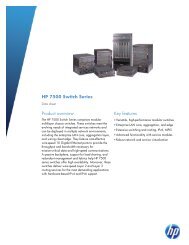Energy Efficient Networking - Business whitepaper ... - HP Networking
Energy Efficient Networking - Business whitepaper ... - HP Networking
Energy Efficient Networking - Business whitepaper ... - HP Networking
Create successful ePaper yourself
Turn your PDF publications into a flip-book with our unique Google optimized e-Paper software.
<strong>Energy</strong> <strong>Efficient</strong> <strong>Networking</strong><br />
<strong>Business</strong> white paper
Table of contents<br />
Introduction..............................................................................3<br />
<strong>HP</strong> <strong>Networking</strong> ........................................................................3<br />
Introducing <strong>HP</strong> Adaptive-Power Architecture.................................3<br />
ProVision, Gen 5—the world’s first Adaptive-Power Architecture<br />
<strong>Networking</strong> Silicon..................................................................4<br />
Adaptive Power Silicon—<strong>Efficient</strong> memory architecture ...............4<br />
Optimizing silicon process losses with<br />
Adaptive-Power Architecture...................................................6<br />
Adaptive-Power Silicon “smart” gating Architecture reduces<br />
Dynamic Power Demand........................................................6<br />
Adaptive-Power Silicon Port Power Control................................7<br />
Adaptive-Power Architecture, inside V2 zl modules platforms..........7<br />
Module-level Adaptive-Power voltage controls.............................7<br />
Individual module power and voltage telemetry...........................8<br />
Adaptive power management using PMC+...................................8<br />
PoE+ Power Controls...............................................................8<br />
<strong>Energy</strong> <strong>Efficient</strong> Ethernet Port Power Controls...............................9<br />
Independent power measurement ..............................................9<br />
Summary...............................................................................10
Introduction<br />
Organizations can get the most from the energy<br />
we use today while moving the world toward more<br />
sustainable energy consumption, management,<br />
and growth by designing and applying more<br />
innovative technologies.<br />
Using the right technology in the right areas of your<br />
business allows you to reduce waste and institute<br />
energy efficiencies that quickly translate to growth in<br />
customer base, increased market share, and enhanced<br />
shareholder value. With increasing pressures to<br />
become more environmentally responsible, failure<br />
to focus on environmental goals can have many<br />
negative repercussions.<br />
By choosing energy-efficient <strong>HP</strong> products,<br />
consolidating with <strong>HP</strong> solutions that streamline<br />
or displace inefficient products and processes,<br />
and controlling energy use with <strong>HP</strong> solutions that<br />
intelligently manage consumption, customers are<br />
cutting their technology’s energy use and costs in<br />
half while improving performance.<br />
Data consumption at a typical office environment is<br />
growing at a furious pace prompting IT to consider<br />
upgrading network equipment from the edge all the<br />
way to the core. Over the past few years there has<br />
been awareness over rising energy costs.<br />
When customers choose <strong>HP</strong> <strong>Networking</strong> equipment<br />
they achieve substantial energy savings with little to no<br />
penalty to throughput or latency. The energy savings<br />
summarized here were observed and analyzed by a<br />
third party.<br />
<strong>HP</strong> <strong>Networking</strong><br />
<strong>HP</strong> is one of the fastest growing networking<br />
vendors in the industry. <strong>Networking</strong> is not new to<br />
<strong>HP</strong>. The <strong>HP</strong> <strong>Networking</strong> division established in 1985<br />
has a long history of innovation. The <strong>HP</strong> <strong>Networking</strong><br />
vision has been to deliver outstanding innovations to<br />
solve key customer problems such as limited flexibility<br />
performance, higher TCO driven by complicated<br />
proprietary standards. <strong>HP</strong> standards-based products<br />
using ProVision ASICs and unified software, offer<br />
excellent balance between performance, features<br />
and price and have been instrumental in adding<br />
true value to customers. Our vision to develop<br />
networking solutions that adapt to changing business<br />
needs is enabling our customers to be successful.<br />
Gartner has ranked us in the leadership quadrant for<br />
networking for over two years, lauding <strong>HP</strong> as having<br />
a vision as well as the ability to execute (http://www.<br />
gartner.com/technology/media-products/reprints/<br />
hpprocurve/article3/article3.html).<br />
Our corporate focus on environmental consciousness<br />
and responsibility pervades all our product lines.<br />
<strong>HP</strong> <strong>Networking</strong> has a range of products covering<br />
every business need from the edge to the core.<br />
The <strong>HP</strong> ProCurve Manager (PCM) software delivers<br />
unparalleled manageability while the <strong>HP</strong> ProVision<br />
ASIC that powers the E-Series products such as the<br />
E8200, E5400, and E3500 Switch series is truly a<br />
switch on a chip, delivering enormous costs savings<br />
to the consumer.<br />
Introducing <strong>HP</strong> Adaptive-Power<br />
Architecture<br />
Traditional networking equipment has been designed<br />
with a primary goal to achieve line rate and to<br />
increase packet processing performance while<br />
decreasing switch latency, power, size, and cost.<br />
However, networking equipment designs from most<br />
vendors focus on reducing peak power consumption.<br />
<strong>HP</strong> <strong>Networking</strong> platforms, built completely around<br />
<strong>HP</strong> Provision Architecture and Silicon, achieve<br />
substantial power savings for all customers and all<br />
deployment situations.<br />
The design principles driving the Adaptive-Power<br />
silicon architecture include:<br />
• Power consumption should scale with utilization.<br />
• Power consumption should be reduced during<br />
idle periods.<br />
• <strong>Networking</strong> performance should never be<br />
compromised by power saving features.<br />
<strong>HP</strong> <strong>Networking</strong> is introducing Adaptive-Power<br />
silicon tailored to the vision of the Adaptive-Power<br />
architecture.<br />
The Adaptive-Power Architecture from <strong>HP</strong> <strong>Networking</strong><br />
was inspired by the realization that, for the majority<br />
of time networking equipment operates; it does not<br />
experience maximum processing load or throughput.<br />
With <strong>HP</strong> <strong>Networking</strong> Adaptive-Power Architecture,<br />
network equipment power consumption can scale<br />
automatically with ports active, traffic intensity, type<br />
of traffic, layer 2, and layer 3 active table depths,<br />
classification complexity, and application environment.<br />
With <strong>HP</strong> <strong>Networking</strong>’s first release of the<br />
Adaptive-Power Architecture, <strong>HP</strong> went beyond<br />
network software manageability tools and focused<br />
on how to reduce power consumption deep inside the<br />
switching platform The Adaptive-Power Architecture<br />
relies on new ASIC’s and hardware platforms<br />
designed from the ground up to reduce power<br />
consumption as a function of utilization.<br />
3
ProVision, Gen 5—the world’s first<br />
Adaptive-Power Architecture <strong>Networking</strong><br />
Silicon<br />
Typically, 60 percent of power consumption<br />
in networking equipment is associated with<br />
packet-processing silicon and packet-processing<br />
support silicon such as memories (DRAM and<br />
TCAM’s). Figures 1 and 2 show the maximum switch<br />
power consumption happens at the packet processing<br />
subsystem. To increase power savings, the best place<br />
to start is to reduce the power consumption associated<br />
with packet processing.<br />
Power consumption in silicon in general and packet<br />
processing specifically is a function of:<br />
• Dynamic losses: With synchronous silicon designs, at<br />
every active clock tick, energy is burned. Dynamic<br />
losses are directly related to the speed of clocks and<br />
the number of clock circuits and associated logic.<br />
Dynamic losses represent 30-70 percent of a typical<br />
packet processor.<br />
• Static/leakage losses: There is some energy loss in<br />
circuits even without clocks toggling. This type of<br />
loss, unfortunately, is growing significantly as silicon<br />
geometries shrink. One of the primary power loss<br />
factors in sub-90nm silicon is leakage associated<br />
with memories, particularly large DRAM’s (Dynamic<br />
Random Access Memory) and TCAM’s (Ternary<br />
Random Access Memory) used in packet buffers, L2,<br />
L3, classifiers, and statistic tables.<br />
There are five critical power management features<br />
inside V2 zl modules platforms:<br />
• <strong>HP</strong> <strong>Networking</strong> Adaptive-Power Provision Silicon.<br />
• Module-level Adaptive-Power voltage controls<br />
• Individual module power and voltage telemetry<br />
• <strong>Energy</strong> <strong>Efficient</strong> Ethernet Port Power Controls<br />
• PoE Power Controls<br />
<strong>HP</strong> <strong>Networking</strong>’s ProVision, Gen 5 ASIC’s (Application<br />
Specific Integrated Circuit) have been completely<br />
redesigned to reduce power consumption. The first<br />
deployment of the Adaptive-Power Architecture is<br />
inside the V2 zl modules 10/100 MbE, 1 GbE, and<br />
10 GbE modular chassis switches. Here are some of<br />
the key technology innovations inside <strong>HP</strong> <strong>Networking</strong><br />
Adaptive-Power ASIC’s:<br />
Adaptive Power Silicon—<strong>Efficient</strong> memory<br />
architecture<br />
The industry-standard packet processor architecture<br />
used in most products today is built around a packet<br />
Figure 1: Typical switch power allocation, stackable 1<br />
13%<br />
Cooling<br />
19%<br />
7%<br />
61%<br />
PHY (1G)<br />
CPU and management I/F<br />
Packet processing and tables<br />
Figure 2: Typical switch power allocation, chassis<br />
11%<br />
Cooling<br />
PHY (1G)<br />
16%<br />
6%<br />
14%<br />
53%<br />
CPU and management I/F<br />
Crossbar fabric<br />
Packet processing and tables<br />
1<br />
Power Conversion subsystem power consumption is included in each of the subsystems power allocation<br />
4
Figure 3: Traditional industry packet processor<br />
L2 DRAM<br />
L3 DRAM<br />
ACL DRAM or<br />
TCAM<br />
MAC<br />
MAC<br />
MAC<br />
L2<br />
Lookup<br />
L3<br />
Lookup<br />
ACL<br />
Traditional Packet Processor Silicon<br />
Mod<br />
Fabric<br />
I/F<br />
Packet buffer and data path I/F<br />
Stats<br />
Packet buffer DRAM<br />
STATS<br />
DRAM<br />
processor silicon device and a number of DRAM<br />
and/or TCAM devices for specific storage needs.<br />
Figure 3 shows a standard packet processor<br />
architecture—focusing and highlighting primary areas<br />
of power consumption.<br />
The traditional architecture has some great<br />
performance characteristics, like high performance<br />
data path, packet processing with deep external<br />
memory tables, and packet buffers for congestion<br />
management. However, one drawback is that it does<br />
not make efficient use of the energy needed to support<br />
the external tables and packet buffers. A simple test of<br />
why this power consumption model is not efficient can<br />
be shown if you were to disable all classification rules<br />
and see if the power consumption goes down. Nearly<br />
all switches on the market today will not decrease<br />
power consumption when ACL rules are disabled or<br />
L2 or L3 tables are decreased in active entries.<br />
In contrast to the industry, <strong>HP</strong> <strong>Networking</strong> silicon is<br />
architected around internal memory vs. external table<br />
and packet storage memories. With the Adaptive-<br />
Power Architecture, power consumption is reduced<br />
Figure 4: <strong>HP</strong> <strong>Networking</strong> Adaptive-Power Silicon Architecture—focus on internal memory partitioning for power reduction<br />
L3 RAM<br />
ACL RAM<br />
L2 Internal RAM<br />
Key<br />
Adaptively disabled,<br />
power saving<br />
memory partition<br />
Active, in use memory<br />
partition<br />
MAC<br />
MAC<br />
MAC<br />
L2<br />
Lookup<br />
L3<br />
Lookup<br />
ACL<br />
Adaptive-Power Packet Processor Silicon<br />
Mod<br />
Fabric<br />
I/F<br />
Packet Buffer & Data Path I/F<br />
Stats<br />
Packet RAM<br />
STATS<br />
5
in memories by innovative design where clocks are<br />
disabled to various memories when memory access is<br />
not required. Further, memory-based tables<br />
are physically sub-partitioned and dynamically<br />
re-organized so parts of the memory devices can<br />
be shut-down if not needed over time.<br />
Optimizing silicon process losses with<br />
Adaptive-Power Architecture<br />
Within every silicon wafer produced, semiconductor<br />
process speed varies greatly across the wafer so that<br />
some chips are fast while other slow—this effect is<br />
amplified with smaller geometry, sub-90nm silicon<br />
devices now employed in 1G and 10G switch<br />
silicon packet processing devices. Since all chips<br />
produced need to deliver line-rate performance, all<br />
chips in traditional networking equipment needed<br />
to be operated at a high voltage to insure at speed<br />
operation for both slower and higher speed silicon.<br />
With Adaptive-Power silicon, each chip manufactured<br />
is calibrated and identified for process speed. This<br />
allows Adaptive-Power platforms to operate at the<br />
exact voltage and power level required to operate<br />
at necessary line rate speed.<br />
This affords huge power savings for higher speed<br />
silicon because power consumption is proportional<br />
to the square of the voltage applied—so even a 5<br />
percent decrease in voltage can produce 10 percent<br />
associated power savings. And there is no penalty for<br />
platforms with lower speed silicon operating at higher<br />
voltages because lower speed silicon consumes less<br />
power for any given voltage than faster silicon.<br />
So, with the Adaptive-Power Architecture, silicon<br />
voltages are scaled so all platforms consumes the least<br />
amount of power necessary for line rate operation.<br />
Adaptive-Power Silicon “smart” gating<br />
Architecture reduces Dynamic Power Demand<br />
With large complex, pipelined synchronous<br />
architectures one power optimization in the silicon<br />
industry is the use of a technique called clock gating<br />
where a clock is shut off to a portion of logic to<br />
reduce dynamic power consumption. Simply put, clock<br />
gating shuts off clocks to portions of logic and there<br />
is no dynamic loss while the clock is gated off (Please<br />
refer to figure 5).<br />
One example of clock gating power reduction is<br />
the amount of power used when a laptop is placed<br />
in “sleep” or “hibernation” modes. You can see the<br />
dramatic power savings potential of clock gating with<br />
the example of a laptop.<br />
However, directly applying clock gating techniques<br />
that work well with general purpose computing<br />
machines don’t work well at all for networking and<br />
Figure 5: Clock gating power control in Adaptive-Power Architecture<br />
ACL RAM<br />
L3 RAM<br />
L2 Internal RAM<br />
Clock<br />
CNTL<br />
Clock<br />
CNTL<br />
Clock<br />
CNTL<br />
MAC<br />
MAC<br />
MAC<br />
L2 Clock<br />
Lookup CNTL<br />
L3<br />
Lookup<br />
Clock<br />
CNTL<br />
Packet Buffer and Data Path I/F<br />
ACL<br />
Adaptive-Power Packet Processor Silicon<br />
Clock<br />
CNTL<br />
Mod<br />
Clock<br />
CNTL<br />
Fabric<br />
I/F<br />
Stats<br />
Clock<br />
CNTL<br />
Clock<br />
CNTL<br />
Process<br />
Speed ID<br />
Packet RAM<br />
STATS<br />
6
Figure 6: Port-specific power savings in Adaptive-Power Architecture<br />
ACL RAM<br />
Not linked<br />
MAC<br />
L2 Internal RAM<br />
L3 RAM<br />
Linked<br />
MAC<br />
L2<br />
Lookup<br />
L3<br />
Lookup<br />
ACL<br />
Mod<br />
Fabric<br />
I/F<br />
Linked<br />
MAC<br />
Adaptive-Power Packet Processor Silicon<br />
Packet Buffer and Data Path I/F<br />
Stats<br />
Not linked<br />
MAC<br />
Packet RAM<br />
STATS<br />
MAC<br />
MAC port in low power,<br />
disabled<br />
MAC<br />
MAC port, enabled<br />
communication systems. <strong>Networking</strong> applications<br />
are inherently time, latency, and throughput sensitive.<br />
Imagine, for example, how latency would increase<br />
astronomically or how much packet loss would be<br />
experienced if you had to rely on your PC to come out<br />
of sleep to handle a newly arrived packet stream?<br />
In order to take advantage the power savings<br />
afforded by clock gating without impacting latency<br />
and throughput, <strong>HP</strong> <strong>Networking</strong> had to develop a<br />
special approach to clock gating—smart clock gating.<br />
Compared with traditional clock gating approaches,<br />
there is similar power savings gained but without the<br />
loss of performance.<br />
<strong>HP</strong> <strong>Networking</strong>’s Adaptive Power Architecture has<br />
designed clock gating techniques across 50 percent<br />
of the die and functional blocks using proprietary<br />
smart clock gating insuring performance is never<br />
compromised while minimizing power consumption.<br />
The smart clock gate governors must be able to<br />
coordinate and anticipate traffic flow through the chip<br />
to insure that specific resources are turned off when<br />
they will not be needed and, very importantly, turned<br />
on just before they need to be used so that throughput<br />
and latency never are impaired.<br />
Adaptive-Power Silicon Port Power Control<br />
Most traditional packet processing silicon does not<br />
automatically disable port-specific logic inside the<br />
packet processor. One of the reasons for this is often<br />
that much port logic is shared between ports so can’t<br />
be disabled in a given port without disabling lots of<br />
functions necessary for the other active ports.<br />
Unfortunately, with traditional switch approaches this<br />
means there is only minimal—if any—power savings<br />
when a port is disabled and not connected. The<br />
Adaptive-Power Silicon offerings from <strong>HP</strong> <strong>Networking</strong><br />
disable many port-specific logic functions when single<br />
ports are disabled.<br />
Adaptive-Power Architecture, inside<br />
V2 zl modules platforms<br />
We’ve already discussed the benefits of<br />
<strong>HP</strong> <strong>Networking</strong>’s Adaptive-Power silicon and its<br />
significant features are discussed in all versions of the<br />
V2 zl modules—from 10/100 MbE to 10 GbE module<br />
configurations—all silicon versions and modes used in<br />
the platforms uses Adaptive-Power silicon.<br />
The other significant platform Adaptive-Power features<br />
in the platforms are described in the next sections.<br />
Module-level Adaptive-Power voltage<br />
controls<br />
Each Adaptive-Power Architecture has local power<br />
conversion that can make:<br />
• Micro voltage adjustments to tune silicon power rails<br />
based on ASIC process speed to decrease power<br />
loss due to silicon process variation<br />
• Macro voltage adjustments based on IO application<br />
requirements (lower voltages for 1 GbE port vs.<br />
10 GbE port for example)<br />
7
Figure 7: Adaptive-Power Platform Architecture<br />
V2 zl modules<br />
Local<br />
Power<br />
V1<br />
Local<br />
Power<br />
V2<br />
Local<br />
Power<br />
Vn<br />
MAC<br />
MAC<br />
PHY<br />
PHY<br />
PHY<br />
Process<br />
ID<br />
zl module, #2<br />
zl module, #3<br />
zl module, #n<br />
Management process module<br />
Power Supply, #1<br />
Power Supply, #n<br />
AC Power Input<br />
With these module level voltage controls, there<br />
are some substantial power savings. Micro voltage<br />
adjustment allows tuning the dominant core power<br />
rail power supplies to least required levels and saves<br />
more than 15 percent of module power for fast silicon<br />
die. Macro voltage adjustments allow savings based<br />
on module application—savings for 1 GbE module<br />
applications is about 5 percent of ASIC power.<br />
Individual module power and voltage<br />
telemetry<br />
The ability to provide a more intelligent understanding<br />
of network element power consumption and what<br />
changes to network configuration and topology would<br />
reduce power consumption depends on network<br />
element power telemetry.<br />
In order to provide a detailed understanding of<br />
power consumption at any given time during<br />
operation, each V2 zl module has telemetry circuitry<br />
providing real-time power monitoring on each of<br />
6-14 voltage rails.<br />
Future releases of management tools such as<br />
<strong>HP</strong> Professional Management center (PMC) and<br />
Intelligent Management center (IMC) will be able<br />
to incorporate telemetry data to provide detailed<br />
network power consumption reports. Management<br />
tools could also be evolved to optimize power<br />
consumption via PoE, EEE configuration, and network<br />
port assignments.<br />
Adaptive power management using<br />
PMC+<br />
<strong>HP</strong> <strong>Networking</strong> PCM+ is a Windows ® -based<br />
network management application designed to<br />
deliver detailed management of <strong>HP</strong> <strong>Networking</strong><br />
devices. <strong>HP</strong> <strong>Networking</strong> PCM+ is designed to<br />
provide cost-effective management, enhanced<br />
security features, and extensibility for small,<br />
medium- sized, and large networks, including remote<br />
sites. It offers analysis of network traffic, advanced<br />
virtual LAN (VLAN) management, and centralized<br />
policy, configuration management, and supports<br />
management of <strong>HP</strong> <strong>Networking</strong> products.<br />
PoE+ Power Controls<br />
One often overlooked area for savings in terms<br />
of power for network devices, especially Power<br />
over-Ethernet (PoE) devices, is that many PoE devices<br />
can be powered off when not in use. Just as you<br />
would turn off the lights or coffee pots in your office<br />
when you leave at night, or over the weekend,<br />
consider a bank of PoE devices that are only used<br />
during business hours.<br />
<strong>HP</strong> <strong>Networking</strong> platforms have had configurable<br />
power saving controls that can disable PoE+ power to<br />
different loads based on policy. <strong>HP</strong> PMC utility, PMC+<br />
has the capability to create schedule-driven policies<br />
that can trigger at specified times on an hourly,<br />
8
a daily, a weekly, or a monthly basis. To Enable the<br />
power saving policy on the <strong>HP</strong> networking switch,<br />
PCM Plus can be configured to schedule a turn off<br />
time and a turn on time for specific POE-connected<br />
devices. This can be done by product groups or<br />
custom groups (groups of devices defined by the<br />
customer). PoE+ ports can be disabled based on time<br />
of day, day of week, etc. With PoE+ ports consuming<br />
up to 30W/port, the network power savings with<br />
smart PoE+ power controls is substantial.<br />
consumption is second only to Packet Processing<br />
silicon (refer to Figure 1). And because EEE is a<br />
inter-network versus internal power saving<br />
mechanisms, power savings is achieved on both<br />
the receiver and the transmitter switch. The periods<br />
of power saving enablement are controlled by a<br />
standard link protocol negotiated on both sides of a<br />
link. Thus, the energy savings are real time and can<br />
be realized across the connected network devices and<br />
is based on industry standards.<br />
Table 1 illustrates an example of energy usage<br />
with and without PMC+ PoE scripting. Assume a<br />
business has 1,000 IP phones, each drawing 5 watts<br />
when idle. If these phones are left on all of the time,<br />
168 hours per week, even at idle they will consume<br />
43,680 kilowatt-hour(s) per year). But if you use PCM+<br />
to disable PoE power to those phones after working<br />
hours and on weekends, they draw power for only<br />
9 hours a day, for a total of 45 hours per week.<br />
Their annual power consumption is reduced to<br />
11,700 kilowatt-hour(s). Disabling PoE power to<br />
the phones in this example saves some 31,980<br />
kilowatt-hour(s) of electricity, reduces the carbon<br />
footprint of the business, and provides significant<br />
cost reductions.<br />
Similar to POE power scheduling, PMC+ can be<br />
scheduled to turn off LEDs during off business hours<br />
when no one is around to look at the LEDs and turn<br />
off power to specific slots within a chassis when not<br />
being used.<br />
<strong>Energy</strong> <strong>Efficient</strong> Ethernet Port Power Controls<br />
<strong>Energy</strong> <strong>Efficient</strong> Ethernet (EEE) is a physical layer<br />
standard that reduces network power consumption by<br />
disabling transmit logic when there are idle periods.<br />
The key to achieving the benefits of EEE is when port<br />
traffic is underutilized. Industry sources believe that<br />
average traffic intensity is less than 10 percent of peak<br />
traffic loads. 2 EEE works right out of the box, and does<br />
not need any management software that requires<br />
additional overhead or monitoring. When two EEE<br />
devices are connected the consumer starts realizing<br />
the energy savings right away.<br />
Depending on traffic patterns and idle periods, power<br />
savings can be fairly substantial because PHY power<br />
Table 1: Power Savings by <strong>Efficient</strong> Power Management<br />
No. of<br />
IP phones<br />
<strong>HP</strong> <strong>Networking</strong> was one of the lead contributors to<br />
the EEE standard and is committed to deploying EEE<br />
enabled switching equipment as widely as possible.<br />
EEE fundamentally aligns to a primary goal of the<br />
Adaptive-Power Architecture—power should scale with<br />
utilization—and the V2 zl modules platforms are the<br />
first EEE enabled switches in the networking industry.<br />
Independent power measurement<br />
<strong>HP</strong> commissioned a study by Tolly group on the<br />
performance, power efficiency and TCO of the E8200<br />
and the E5400 series products in Nov 2010. Tolly<br />
group after a comprehensive study concluded that:<br />
“The PoE+ enabled E8212 consumed 369W on<br />
average; while the PoE enabled Catalyst 4506<br />
consumed 468W. This represents a power savings of<br />
~21 percent with the E8212, resulting in about $360<br />
savings in electric and cooling costs per switch over a<br />
3-year period compared to an identically configured<br />
Catalyst 4506. Similarly, the E5412 consumed 332W<br />
versus 447W consumed by a four-switch stack of<br />
Catalyst 3750-X switches. This represents almost<br />
~26 percent power savings and $420 in electric and<br />
cooling cost savings with a E5412 compared to a<br />
stack of Catalyst 3750-X over a 3-year period. Finally,<br />
a 48-port E5406 chassis consumed 5 percent less<br />
power than a comparable Catalyst 3750-X fixed<br />
port switch.”<br />
<strong>HP</strong> <strong>Networking</strong>’s hard work designing a purpose<br />
built ASIC from the ground up paid off, delivering<br />
substantial savings for the enterprise.<br />
“Over a period of 3 years, the E8212 cost $222 per<br />
Gbps of throughput delivered, compared to $2,119<br />
for the Cisco Catalyst 4506. Put in another way, the<br />
E8212 consumed 2.3 watts per Gbps of throughput<br />
Watts/Phone at Idle Hrs/week <strong>Energy</strong> consumed/<br />
year<br />
<strong>Energy</strong> cost/year<br />
(@ US$0.11/kW)<br />
PoE off time 1000 5 168 43680 kW $4804<br />
PoE on time 1000 5 45 11700 kW $1287<br />
Total savings by efficient power management 31,980 kW $3517<br />
2<br />
http://www.networkworld.com/news/2010/030310-energy-efficient-ethernet.html<br />
9
Figure 8: Enterprise deployment showing power savings in switches and at supported EEE endpoints<br />
Data center<br />
E5400<br />
E8212zl<br />
Core<br />
10G<br />
E8212zl<br />
Router MSR<br />
EEE power<br />
savings<br />
Internet<br />
10G<br />
10G<br />
WAN<br />
Unified Management<br />
• PCM+<br />
• IDM<br />
E5406<br />
Building<br />
E5406<br />
Branch<br />
PoE<br />
PoE+<br />
Secured<br />
mobility<br />
IP telephony<br />
IP Telephony<br />
Access points<br />
End points<br />
supporting EEE<br />
delivered, while the Catalyst 4506 consumed 9x more<br />
power at 20.8 watts per Gbps. Similarly, the E5412<br />
cost $139 per Gbps compared to $1,177 per Gbps<br />
for the 4-switch stack of the Catalyst 3750-X over a<br />
3-year period. In other words, the E5412 consumed<br />
2 watts per Gbps of throughput delivered, while the<br />
Catalyst 3750-X consumed 4x more power at 8 watts<br />
per Gbps over a 3-year deployment period.”<br />
Summary<br />
When customers choose <strong>HP</strong> <strong>Networking</strong> equipment,<br />
they can be sure that through our research and<br />
innovation, their equipment will have the best-in-class<br />
energy efficiency and configurability. By enabling EEE,<br />
<strong>HP</strong> <strong>Networking</strong> has adopted standards that enable<br />
simple plug and play power savings without the need<br />
for cumbersome management software or licenses.<br />
With the Adaptive power management architecture,<br />
best in class design principles were implemented to<br />
enable power saving at the ASIC, module and LAN<br />
deployment levels.<br />
Independent power measurement and analysis has<br />
proved that these innovations actually deliver value<br />
in realizable dollars to the consumer and do provide<br />
continual incremental savings over the life of the<br />
networking deployment.<br />
10
Table 2: Power Savings when using <strong>HP</strong> <strong>Networking</strong> E8200/E5400 switches (Tolly Report)<br />
Watts/Gbps<br />
US$/Gbps<br />
25.0<br />
12.5<br />
0<br />
$2,200<br />
$1,100<br />
$0<br />
Power utilization efficiency (Watts per Gbps of throughput) delivered<br />
2.3<br />
(Lower values are better)<br />
2.1<br />
<strong>HP</strong> E8212 <strong>HP</strong> E5412 Cisco Catalyst 3750-X<br />
in a 4-Switch Stack<br />
Price/performance ratio (US$ spent per Gbps of actual throughput delivered)<br />
$222<br />
(Lower values are better)<br />
$139<br />
8.0<br />
$1,177<br />
<strong>HP</strong> E8212 <strong>HP</strong> E5412 Cisco Catalyst 3750-X<br />
in a 4-Switch Stack<br />
20.8<br />
Cisco Catalyst 4506<br />
$2,119<br />
Cisco Catalyst 4506<br />
$16,000<br />
Additional power and cooling costs over 3 years<br />
from using 144 GbE-port Cisco Switches over <strong>HP</strong> Switches in a 5,000-port deployment<br />
US$<br />
$8,000<br />
$0<br />
$12,882.1<br />
(22.5% more)<br />
4-Switch Stack<br />
of Cisco<br />
Catalyst 3750-X<br />
over <strong>HP</strong> E5412<br />
$15,530.6<br />
(17.4% more) $9,938.3<br />
(26.0% more)<br />
Cisco Catalyst 4506<br />
over <strong>HP</strong> E5412<br />
4-Switch Stack<br />
of Cisco<br />
Catalyst 3750-X<br />
over <strong>HP</strong> E8212<br />
$12,586.7<br />
(21.0% more)<br />
Cisco Catalyst 4506<br />
over <strong>HP</strong> E8212<br />
Solution<br />
under test<br />
<strong>HP</strong> E8212<br />
<strong>HP</strong> E5412<br />
Cisco Catalyst 3750-X<br />
Cisco Catalyst 4506<br />
Solution port<br />
configuration<br />
144 GbE PoE+ports, 2x 10 GbE<br />
ports in a pair<br />
144 GbE PoE+ports, 2x 10 GbE<br />
ports in pair<br />
Stack of four switches with 72 PoE<br />
and 72 non-PoE<br />
GbE ports, 2x 10 GbE ports:<br />
(WS-C3750X-24-T-S, WS-C3750X-<br />
24-P-S, WS-C3750X-48-P-S and<br />
WS-C3750X-48-T-S)<br />
144 GbE PoE ports in Snake<br />
Config, 2x 10 GbE ports in a pair,<br />
two PSUs (one power input to each)<br />
Projected 3-year<br />
power and<br />
cooling cost 3<br />
(US$)<br />
Power and<br />
cooling costs in<br />
a 5,000-port<br />
deployment<br />
$1,350 $47,250.35<br />
$1,266 $44,306.50<br />
Additional<br />
power and<br />
cooling Cost<br />
over <strong>HP</strong> E5412<br />
– –<br />
Additional<br />
power and<br />
cooling cost<br />
over <strong>HP</strong> E8212<br />
$1,634 $57,188.60 $12,882.10 $9,938.25<br />
$1,710 $59,837.05 $15,530.55 $12,586.70<br />
Source: Tolly, September 2010<br />
3<br />
Formula used = (W ATIS<br />
/1000)*(3*365*24)*(0.1046)*(1.33), where<br />
• W ATIS<br />
= ATIS weighted average power in Watts<br />
• 3*365*24 = 3 years @ 365 days/yr @ 24 hrs/day<br />
• 0.1046 = U.S. Average retail cost (in US$) of commercial grade power as of June 2010 as per Dept. of <strong>Energy</strong> Electric Power Monthly<br />
(http://www.eia.doe.gov/cneaf/electricity/epm/table5_6_a.html)<br />
• 1.33 = Factor to account for power costs plus cooling costs @ 33% of power costs.<br />
11
Table 3: Weighted Average Power Consumption when using <strong>HP</strong> <strong>Networking</strong> E8200/E5400 switches (Tolly Report)<br />
150<br />
Weighted power consumption of Access Switches with 48 PoE+/PoE GbE<br />
4<br />
ports as per ATIS recommendations<br />
(lower values are better)<br />
Watts<br />
100<br />
50<br />
126<br />
132<br />
0<br />
<strong>HP</strong> E5406 Cisco Catalyst 3750-X<br />
in a 4-Switch Stack<br />
500<br />
Weighted power consumption of Access Switches with up to<br />
144 PoE/PoE+ GbE ports and two 10 GbE ports as per ATIS recommendations<br />
(lower values are better)<br />
4<br />
400<br />
Watts<br />
300<br />
200<br />
369<br />
346<br />
447 468<br />
100<br />
0<br />
<strong>HP</strong> E8212<br />
<strong>HP</strong> E5412<br />
Cisco Catalyst 3750-X<br />
in a 4-Switch Stack<br />
Cisco Catalyst 4506<br />
Source: Tolly, September 2010<br />
4<br />
ATIS-weighted Power (W ATIS<br />
) = 0.1*(Power draw @ 0% load) + 0.8*(Power draw @ 10% load) + 0.1*(Power draw @ 100% load), as defined in ATIS<br />
standards ATIS-0600015.03.2009 and ATIS-0600015.2009<br />
Note:<br />
Test traffic consisted of an Internet Mix (iMIX) distribution of TCP packet sizes: 57% at 64-bytes, 7% at 570-bytes, 16% at 594-bytes and 20% at<br />
1,518-bytes<br />
Understand how <strong>HP</strong> <strong>Networking</strong> EVPG illustrates what “Green” means and how by enabling EEE, <strong>HP</strong> <strong>Networking</strong> has adopted<br />
standards that enable simple plug and play power savings without the need for cumbersome management software or licenses.<br />
Visit http://h30501.www3.hp.com/t5/BriefingsDirect-by-Dana-Gardner/<strong>Energy</strong>-efficient-Ethernet-switch-modules-from-<br />
<strong>HP</strong>-help-cut-power/ba-p/14403.<br />
Get connected<br />
www.hp.com/go/getconnected<br />
Get the insider view on tech trends, alerts, and<br />
<strong>HP</strong> solutions for better business outcomes<br />
© Copyright 2011 Hewlett-Packard Development Company, L.P. The information contained herein is subject to change without notice. The only<br />
warranties for <strong>HP</strong> products and services are set forth in the express warranty statements accompanying such products and services. Nothing herein<br />
should be construed as constituting an additional warranty. <strong>HP</strong> shall not be liable for technical or editorial errors or omissions contained herein.<br />
Windows is a U.S. registered trademark of Microsoft Corporation.<br />
4AA3-3866ENW, Created May 2011



